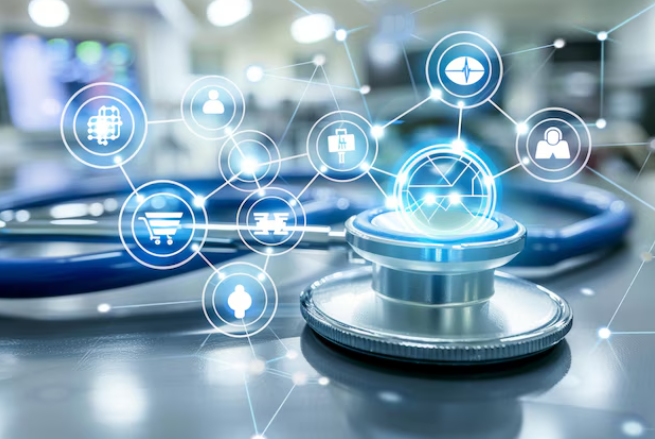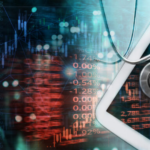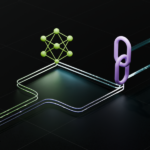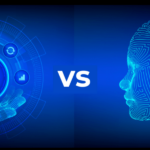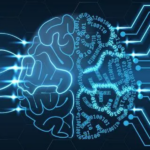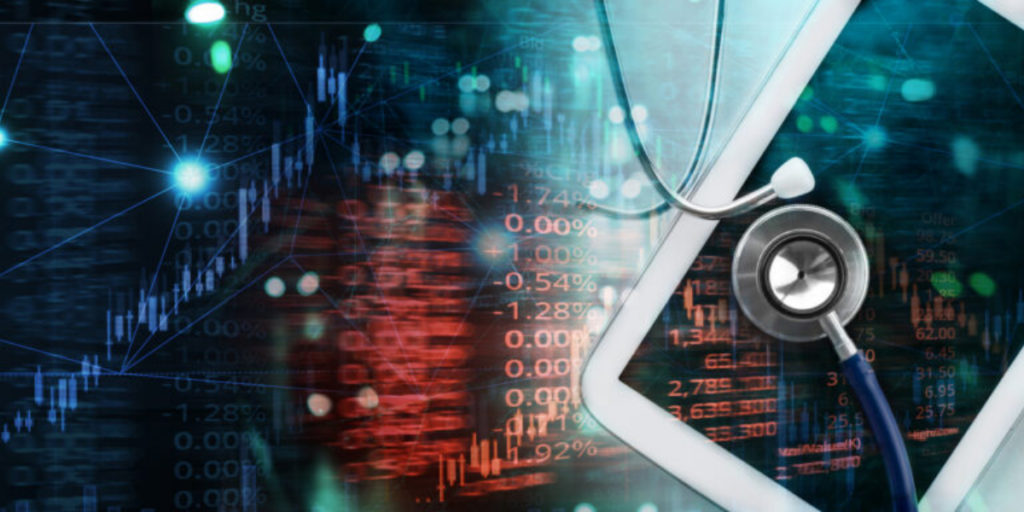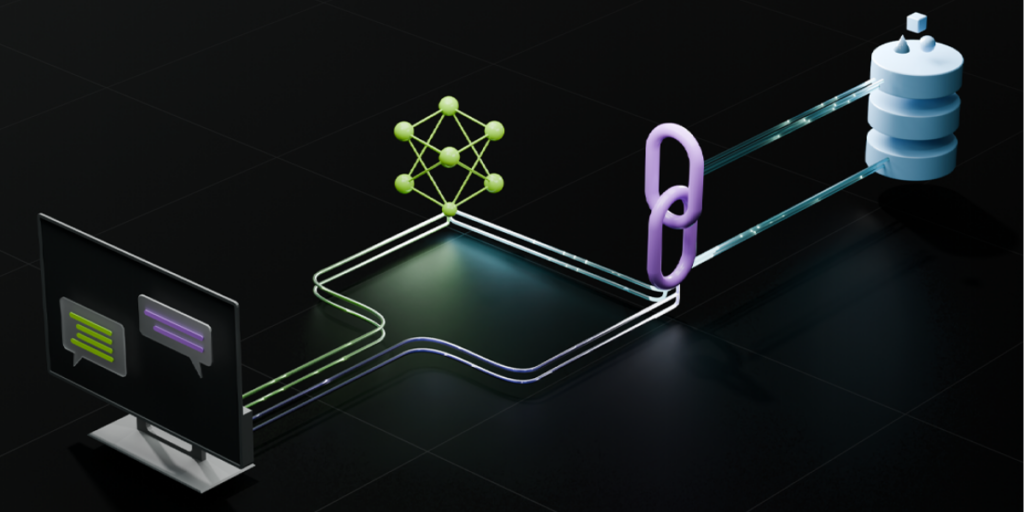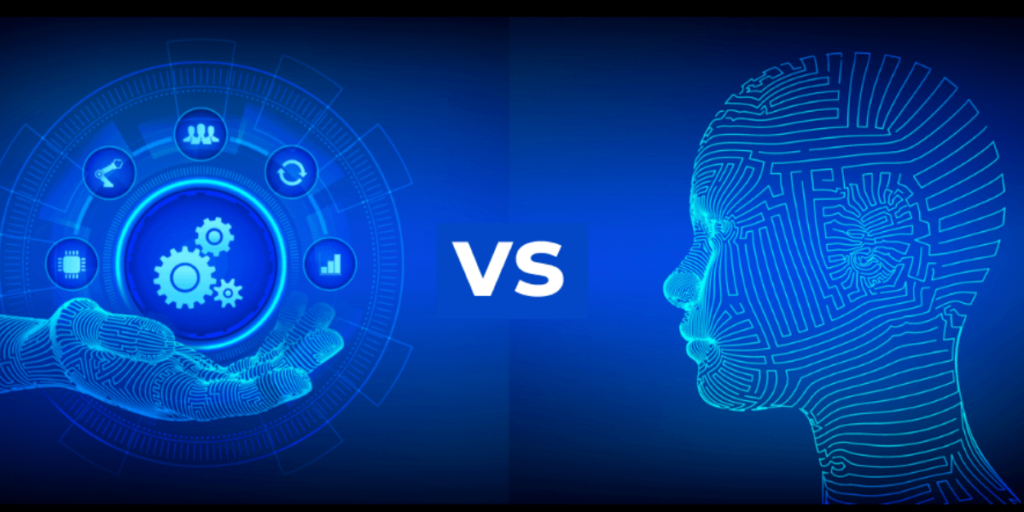Technology has revolutionized the way that medical devices work, communicating and providing the patient experience. The integration of technology like the IoT for connected medical devices is paving the way for advancement within the healthcare industry. We’ll look at the basic principles of these advances and the way IoT transforms medical technology. We will also discuss important issues of privacy and security.
The field of healthcare is always changing, and thanks to technological advancements, a brand new participant in the industry is emerging: IoT, or the Internet of Things (IoT). IoT in healthcare utilizes connected sensors and devices to gather information. It analyses the data to help doctors make better decisions and deliver better healthcare.
IoT for healthcare offers enormous potential to improve the quality of patient care, reduce costs, and help improve the healthcare system’s efficiency. However, there are some challenges. These include privacy and security issues, interoperability concerns, and compliance with regulatory requirements.
Intriguingly astonishingly, this IoT medical device integration marketplace is expected to grow from $127.7 billion in 2023 to $289.2 billion by 2028.
Market Statistics of IoT for Connected Medical Devices
It is used for diagnostics, care delivery, prevention, and disease management; IoT for connected medical devices can cut unnecessary visits to the clinic by 25% and hospitalization by 33%. It also could save 30 percent of medical personnel’s time on vitals entry.
The IoMT market for medical devices with connectivity (stationary, implantable, wearable) was estimated at $26.5 billion by 2021. In 2026, it’s projected to reach $94.2 billion, increasing at an annual rate of 28.9 percent.
The market’s growth is driven by IoT technology and advances in medical device connectivity (e.g., 5G or Bluetooth). Other drivers for adoption include increasing healthcare costs, the rising number of chronic diseases, and the increasing emphasis on the quality of healthcare and patient safety.
How IoT Can be Used in Medical Devices?
Imagine that you’re driving on a long drive. You’re driving along and suddenly see the fuel gauge dropping quickly. Without additional details, you’re left with the question of the exact time and location you’ll be able to refill.
Imagine if your car came with an IoT system that monitored your fuel level, your location, and even the closest petrol stations. It could even notify you when you’re running low on fuel and direct you to the closest station. This is similar to how IoT in healthcare functions.
IoT in healthcare involves using sensors and devices that collect data from patients in real time. These data may include vital indicators such as medication adherence and vital signs, as well as other health-related information.
This IoT device monitoring system examines the information and provides healthcare professionals with data that can help them make educated decisions regarding patient treatment. The system allows healthcare providers to monitor patients from a distance, monitor their health, and identify potential health issues.
Its IoT system tracks fuel levels and location. IoT in Healthcare tracks patient health. It provides valuable information for healthcare providers, which is why IoT aids in patient care. Healthcare providers can provide better and more efficient treatment.
IoT in Healthcare for Connected Medical Devices
IoT devices present a myriad of new possibilities for healthcare professionals to monitor their patients and patients to track themselves. In turn, the array of devices that wear IoT devices offers a variety of advantages and issues for healthcare professionals and patients as well.
Glucose Monitoring
For the greater than 30 million Americans who suffer from diabetes, monitoring glucose levels is a challenge. It is not only inconvenient to test glucose levels manually and then take notes while doing it, but reporting a patient’s glucose levels only at the exact moment the test is administered is also inconvenient. If the levels fluctuate, the frequency of testing might not be enough to determine an issue.
IoT devices can address these issues by offering constant, automatic monitoring of glucose levels for patients. The glucose monitoring devices remove the requirement of keeping documents manually. They can notify patients if their glucose levels are low.
The challenges include the creation of an IoT device to monitor glucose that can:
- Small enough to allow monitoring constantly without causing disturbance to patients
- It doesn’t use too much power and must be regularly recharged.
These aren’t insurmountable obstacles. However, products that address these issues are likely to transform the way diabetics monitor their glucose levels.
Hand Hygiene Monitoring
There hasn’t been an effective way to ensure that patients and providers inside the healthcare facility wash their hands properly to limit the possibility of spreading infection.
Many hospitals and other healthcare institutions utilize IoT gadgets to alert patients to wash their hands before admission. These devices also provide directions on how best to wash hands to minimize any risk specific to the patient.
The biggest issue is that devices only remind users to wash their hands; they don’t perform the task for them. However, studies suggest that these devices could reduce the infection rate by more than 60 percent in hospitals.
Parkinson’s Disease Monitoring
Medical professionals should be able to determine the extent to which Parkinson’s patients’ symptoms vary throughout the day to manage them with the most effective treatment.
IoT sensors will aid in this process by continuously collecting data on Parkinson’s symptoms. In addition, the devices allow patients to lead their lives at home instead of spending longer periods in hospitals being watched.
Connected Medical Equipment
IoT for healthcare can be utilized to connect medical equipment like hospital beds and infusion pumps to the Internet. This allows continuous monitoring of equipment performance in conjunction with predictive maintenance and automated alerts when malfunctions occur.
This can increase the accessibility of medical devices, decrease the time it takes to repair them and ensure that patients receive top-quality treatment at the appropriate time.
Remote Patient Monitoring
Remote monitoring of patients is the most popular use of IoT devices in healthcare. IoT devices can collect health indicators such as blood pressure, heart rate, and temperature from patients who aren’t physically present at a healthcare facility, eliminating the requirement of patients traveling to healthcare providers or taking the data themselves.
If an IoT device collects patient data and transmits it to a computer program for health professionals and/or patients to examine, algorithms can be utilized to analyze the data to suggest treatment options or generate alerts. For instance, an IoT sensor that detects a patient’s unusually low heart rate can trigger an alert to ensure healthcare professionals can intervene.
A major issue with remote monitoring devices is ensuring that the sensitive data collected by these IoT devices is safe and secure.
Heart-Rate Monitoring
Similar to glucose, keeping track of heart rate can be difficult even for patients in health facilities. The periodic heart rate check doesn’t protect against sudden fluctuations in heart rates, and traditional equipment for continuous monitoring of the heart employed in hospitals requires patients to be connected to machines via wires for a long time, which can limit their mobility.
Nowadays, tiny IoT devices are used to monitor heart rates and allow patients to move freely while ensuring their heartbeats are continuously monitored. It isn’t easy to guarantee ultra-accurate results. Of a problem; however, most devices today can provide 90% or higher precision rates.
Smart Hospital Infrastructure
IoT in healthcare could be utilized to build intelligent infrastructure for hospitals. This can include technology for managing energy and patient flow.
This improves efficiency, cuts down on waste, and creates a more relaxing and secure setting for patients.
Depression and Mood Monitoring
Information on symptoms of depression and general mood is a different kind of data that has been difficult to obtain constantly. Health professionals might check on how patients feel but couldn’t predict abrupt mood shifts. Most of the time, patients do not share their emotions accurately.
“Mood-aware” IoT devices can solve these issues. By analyzing and collecting information such as blood pressure and heart rate, devices can provide the patient’s mental state. The most advanced IoT devices to monitor mood can track even more data, like eye movements.
The main issue here is that such measures cannot predict the symptoms of depression or other issues with absolute certainty. The same is true for traditional psychological assessment in person.
Wearable Health Devices
IoT app development has reached a new level of creativity. Wearable health devices, like smartwatches and fitness trackers, are among the most popular applications of IoT in healthcare. These devices can collect and analyze data on a patient’s physical activity.
Additionally, they can analyze sleep, heart rate, and other health-related metrics. These data can be utilized to develop individual health plans. Thus, it allows patients to play a more active part in regulating their health.
Why is Security a Paramount Consideration for IoT Connected Medical Devices?
Major security issues must be resolved to get the most from IoT in healthcare.
Most importantly, IoT device developers, managers, and healthcare providers need to ensure that the data gathered through IoT devices is adequately secured. A large portion of the information collected by medical devices is classified as protected health data under HIPAA and similar rules.
This means that if IoT devices aren’t properly secured, they could steal sensitive data. In fact, 82 percent of healthcare institutions have reported attacks on the security of their IoT devices.
One of the first steps to address this issue is making security-conscious IoT devices and applications. Equally important is ensuring that IoT devices used in healthcare settings are properly managed to guard against information from unmonitored devices that could fall into improper hands.
A device used to monitor patients runs outdated firmware or software or is not properly removed when it’s not in use. This may allow attackers to penetrate a network and obtain confidential health data.
Proper classification and discovery of all IoT devices connected to healthcare providers’ networks helps protect against this risk. Once IoT device networks are classified, identified, and secured, managers can monitor device activity to detect anomalies, perform risk assessments, and differentiate at-risk devices from mission-critical devices.
How to Ensure Security of Connected Medical Devices?
Effective cybersecurity begins with knowing what is required to be protected. That’s why having a complete device inventory is a key element of an HDO security journey. The HDO can tackle its issues with device discovery by following these methods:
Get Full Visibility of Connected Clinical Devices
Companies should begin their path toward operational and cyber resilience by gaining complete visibility into the connected devices within their clinical space. The first step is to identify the areas of blindspots in their asset inventory, ranging from equipment for medical use and IoT devices to creating the management system (BMS).
The combination of passive and light-active collecting techniques and the ability to work with more than 500 communication protocols allows HDOs to understand and monitor every device, their activity, and how they connect to and communicate with each other.
Extend IT Security and Governance to Clinical Settings
After integrating this new access into your existing technology stack, you can expand your IT security measures across your hospital’s clinical or non-clinical procedures. This will allow hospitals to consolidate their security management and guide all use cases toward operational and cyber resilience.
Integrate with your IT Workflows and Stack
Once they understand devices’ connectedness, they might discover issues in governance across IT workflows. To ensure the security of healthcare delivery environments, companies are urged to expand their existing IT and OT devices and workflows.
Emerging Trends in IoT Connected Medical Devices
The connected medical device market is fast changing, with a variety of major trends that will shape the future of technology for healthcare:
Artificial Intelligence Integration
Machine learning and AI algorithms are being integrated into connected devices to increase diagnosis capabilities and treatment management. For instance, wearables with AI technology can detect atrial fibrillation and its symptoms accurately, which could help prevent strokes and other cardiovascular issues. These wearables can process massive amounts of patient information in real-time, enabling more targeted and proactive care.
5G Technology
The advent of 5G network technology is revolutionizing connectivity to medical devices, allowing extremely fast, low-latency communications. This allows remote surgeries, the rapid exchange of massive medical data, and more reliable telemedicine.
5G connectivity enables immediate monitoring and intervention, which is particularly useful for situations requiring critical care and remote patient monitoring.
Edge Computing
Edge computing is integrated into connected medical devices to combat latency problems and reduce the need for cloud infrastructure. This enables immediate data collection at points of service, making it easier to make decisions faster and lessening the burden on network resources.
Edge computing is especially important for applications that require instantaneous response, such as constant glucose monitors or cardiac event detection.
Miniaturization and Implantables
There’s a rising trend towards smaller, less invasive devices. Miniature and implantable sensors are developing to continuously check various bodily functions and can even deliver exact doses of medications. For instance, a grain-sized sensor is being developed to deliver specific drug treatments for brain tumors.
Blockchain for Data Security
As data security concerns grow, the use of Blockchain technology has been studied to increase the integrity and security of medical device information. Blockchain technology can offer an efficient, secure, and decentralized system for sharing and storing patient information, thereby revolutionizing medical information exchange while preserving confidentiality.
Augmented and Virtual Reality
AR and VR technology are integrated into connected medical devices to support various applications, such as surgical procedure planning, education, and patient rehabilitation. These immersive technologies improve the precision of procedures and offer unique methods for the patient to participate in the healing process.
Biometric Authentication
To improve safety and enhance user experiences, biometric authentication methods such as fingerprint scanning, facial recognition, or voice recognition are now being integrated into connected medical devices. This not only improves the security of devices but also facilitates interaction with users, especially for those with mobility issues.
Major Challenges of Implementing IoT in Healthcare Industry
These devices require robust platforms seamlessly integrated into existing infrastructure and systems. To ensure successful IoT applications in healthcare, these conditions must be met.
Reliable Connectivity
In devices that require immediate access to data, which is what numerous medical devices have. Connectivity is particularly difficult for mobile devices such as wearables, which can travel wherever the patient is, even beyond boundaries and coverage areas.
Cellular connectivity is usually the most effective solution for IoT deployments covering a wide geographic area. With an unlocked, roaming, and non-steered SIM card, IoT devices can automatically change networks and remain connected to the best available signal. The range of networks accessible is contingent upon the SIM provider’s roaming arrangements and the location of the deployment.
There are various types of connectivity for mobile devices. It is essential to match the type of network with the cost speed, speed, or voice capabilities your devices require. Check out our short guide on IoT connectivity to understand your options.
Integration with a variety of Devices & Protocols
The interconnection of different kinds of devices can cause problems with the use of IoT within the healthcare industry. This is because device makers aren’t able to reach a consensus on the protocol for communication and standards.
This creates a situation in which each manufacturer develops its own distinct environment made up of IoT devices that don’t connect to the devices and applications from other manufacturers. In this situation, there isn’t a standard synchronous protocol that can be used to aggregate data. The non-uniformity slows down the process and decreases the scalability potential of IoT within healthcare.
Cost
This fact is not surprising. Costs are among the most difficult aspects to consider when deciding to use IoT apps to help healthcare providers with mobility. However, the expense is worth it if your IoT application solves the real issue.
Although you’ll have to invest substantial cash and effort to develop IoT applications, the benefits will be huge. IoT software’s benefits are equally impressive if your business can save time and labor, improve business processes, generate additional revenue streams, and generate more opportunities for business through IoT.
Cybersecurity
Any device linked to the web may be hacked, and IoT devices are no exception. Healthcare technology needs extra security because of its delicate nature and the regulations in place to ensure patient privacy.
An encrypted IoT network is a vital starting point. VPNs, APNs, and IPsec protocols create a private network that can only be accessed by authorized devices. These protocols keep data in the private network and away from the public internet. They are complemented by strict data management procedures, clear ownership boundaries, and your company’s security policies to fight security breaches, hacks, and leaks.
Data Security and Privacy
One of the major problems faced by IoT healthcare software is data security and Privacy. Mobile devices with IoT capabilities can collect data in real time, but the majority of them do not adhere to data standards and protocols.
There is a great deal of uncertainty about data ownership and regulations. Therefore, data stored on devices that are IoT-enabled is more susceptible to theft and also makes it more vulnerable to cybercriminals who can hack into systems to access personal health information.
The most common misuse of IoT device data includes fraudulent health claims as well as the creation of fake IDs to purchase and sell prescription drugs.
Data Overload and Accuracy
Because of the inconsistent nature of the data and communication protocols, it’s difficult to collect data for important understanding and research. IoT gathers data in large quantities, and for proper analysis, data has to be sorted into segments without overloading and with exact precision for more effective outcomes. Furthermore, the overloading of data could influence the decision-making process within the hospitality industry over time.
The Key Takeaway
Healthcare IoT connects millions of devices. It is awash with billions of information points that are hard to trace and monitor and can lead to the risk of the system being compromised and used for a variety of purposes. Information security is vital. IoT data security and privacy have been listed as top issues that need to be addressed before its too late.
Because these devices are connected, hackers can take advantage of a blind spot and alter data. The alteration will not only cause disruption to the connections and processes but can also trigger the leak of sensitive personal information such as addresses, names, and more.
The security of medical devices is essential for all healthcare organizations. Being aware of all medical IoT gadgets, their locations, connections, and capabilities is vital for establishing a sound healthcare cybersecurity strategy and ensuring that the devices are operating efficiently and processes are running smoothly. We constantly adjust to the most recent technologies to optimize our processes and improve our operations, and we also prioritize their security.
How A3logics Can Help You with IoT Implementation?
At A3logics, we specialize in providing cutting-edge IoT healthcare software solutions tailored to medical institutions’ particular requirements. Our team of specialists has decades of experience with IoT implementation, ensuring seamless integration of medical devices connected to your healthcare environment.
From strategy creation through deployment and ongoing maintenance, we provide complete support to help you improve operational efficiency and patient outcomes. We make use of advanced technology to allow the collection of data in real-time monitoring and analysis to ensure compliance with healthcare requirements and guidelines.
When you partner with A3logics, you gain access to a reputable team committed to maximizing the benefits of IoT in connecting medical devices. Let us assist you in transforming your clinic with innovative solutions that are changing the way healthcare is delivered. With our collective efforts, we will build an improved, safer, more secure, and integrated healthcare network.
FAQs
What does IoT mean in the context of healthcare?
IoT in healthcare refers to the use of connected devices on the Internet to gather and share health information to better treat patients.
How is IoT being applied in the healthcare sector?
In healthcare, IoT is monitoring patients remotely, observing vital signs using wearables, and increasing the efficiency of the medical process.
What are some IoT products used in healthcare?
IoT products for health care include wearable health monitors, remote monitoring of patient systems, and smart medical equipment.
What is the impact of IoT on the healthcare industry?
IoT has enhanced patient monitoring, access to care, and treatment options. Additionally, it improves the efficiency of healthcare facilities’ operations.
How can IoT devices be effectively managed?
Users can manage IoT devices with mobile applications, web interfaces, voice commands, or centralized IoT platforms.

